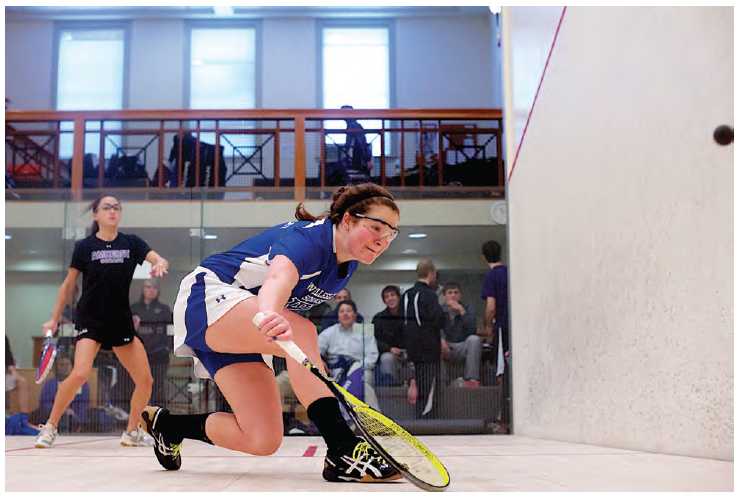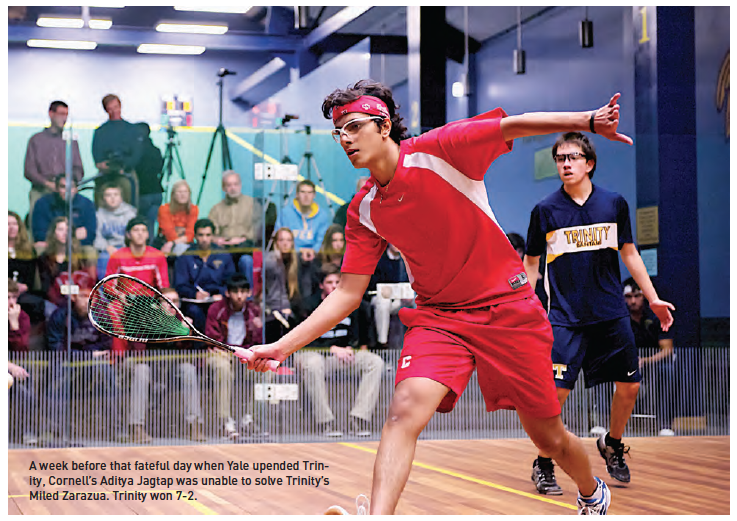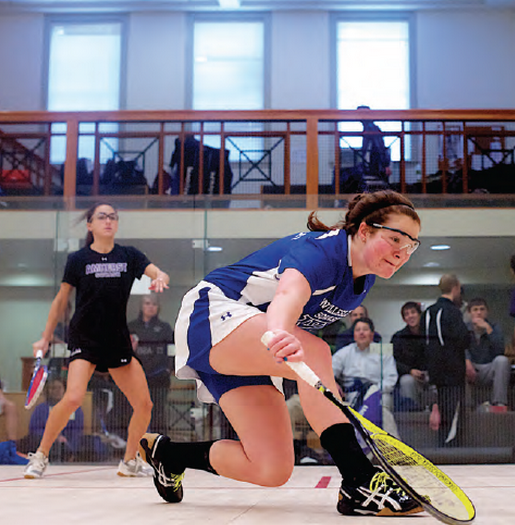By Anne Bello
Photos by Michael Bello
Throughout its history, college squash has lived in cycles. After all, only five men’s schools (Princeton, Yale, Harvard, Navy, and Trinity) and five women’s schools (Princeton, Yale, Harvard, Penn, and Trinity) have captured the nine-player national championship in the combined 108 seasons of college squash.
Last season there were several dramatic shifts. Many squash fans know where they were on January 18, 2012, when Yale ended the 252-match win streak by the Trinity men. For the first time since 1998, Trinity did not win the Men’s National Team Championships, although they came very close. Princeton took advantage of hosting the tournament and earned a 5-4 come-from-behind victory. On the women’s side, last season marked the 40th National Team Championship, and Harvard survived tough 5-4 regular season matches to complete an undefeated season and earn their second championship in three seasons.
The 2012/2013 season looks to continue the excitement from last year. For seniors, this year’s National Team Championships will be a return to the beginning of their college squash careers. In the College Squash Association’s current tournament rotation system, the same schools host the National Team Championships every four years. As a result, many players compete in their final team match at the same place where they played in their first team championship.
This year, the men’s and women’s National Team Championships will be returning to Yale, and the women will be up first, taking to the courts February 15-17. Defending champions Harvard look to be formidable again, especially with former individual champion Laura Gemmell at No. 2 and defending individual champion Amanda Sobhy at No. 1.
The Penn women haven’t reached the Howe Cup finals since 2010, but they have been rebuilding ever since. Last year no starters graduated, and this may be the year the Quakers are ready to be back in the spotlight.

But the team with the best shot at taking down Harvard is Yale. The Crimson may have cruised to an 8-1 win over Yale in the championship final last year, but a week earlier the Bulldogs had Harvard on the ropes in a dual match at Yale’s Brady Squash Center, narrowly losing 4-5. Yale will have the home court advantage again if they make it back to the championship finals. As last year’s finals proved, home court advantage can be a significant factor, and nowhere is that more true than at Yale. The Brady Squash Center’s large galleries, narrow hallways, and balconies can make the large space seem very small. When packed with hundreds of rowdy Bulldogs fans, it becomes a pressure-cooker for the away team. With several veteran players returning to full strength after illness and injury, Yale should be even stronger this year.
Only one other team managed to put significant pressure on Harvard last season, and that was Princeton. The Tigers pushed the Crimson to 4-4 before falling in their dual match, and this time around Princeton will play Harvard at home during the regular season. The Trinity women are usually in the mix for the national title and should be again this year, particularly after finishing ahead of Princeton last season.
When the men’s tournament starts on February 22, it may be the most wide-open contest in over a decade. Defending champions Princeton may be the sentimental favorites. The team won the Sloane Award for team sportsmanship last season, and head coach Bob Callahan, who has been facing serious health issues, was recently inducted into the U.S. Squash Hall of Fame. Princeton has a lot of good will—and a national title. However, the team lost a number of seniors last year and may have more ground to make up than other contenders.
Trinity, Princeton’s opponent in last year’s final, find themselves in unfamiliar territory. For the first time since 1998, the Bantams aren’t defending champions, and there’s no streak on the line. However, Trinity may be on an upward trajectory. For the last few years, the Bantams seemed to lose most of their starting line-up coming into the new season, but this year they have lost just two starters to graduation. They won the last time they played for the national title at Yale, and they want to be back on top.

In the end, it may be Harvard that is the men’s squad to watch this season. The Crimson made it back to the semifinals for the first time since 2009, and they’ll have defending individual champion Ali Farag back. Cornell and Rochester, two squads that have made big strides in recent seasons, will likely be rebuilding this year and may not be as much of a factor. And then there’s Yale: the Bulldogs were at the top of the world midseason last year, ranked No. 1 after ending Trinity’s streak. A string of injuries deflated the Bulldogs, and they limped into the end of the season, finishing sixth overall. But Yale thrives on being the underdog, and the Bulldogs lost to Trinity in the title match four years ago at the Brady Squash Center. That memory and home court advantage may spur Yale back into the national championship hunt.
Outside of the men’s and women’s A Divisions it’s anyone’s game— and that’s a good sign. It’s telling that many of the lower division champions aren’t content to defend their titles; they want to move up into the next division. A number of teams drew notice with significant improvement last season, among them Columbia, who won the Barnaby Award as the most improved men’s team, and Middlebury, who won the Most Improved Team Award for the women. The St. Lawrence men had a program-best finish in 2012, and the Franklin and Marshall women have been steadily improving as well. George Washington pulled off two titles, taking the men’s and women’s C Division, and that’s another program on the rise.
The upward trajectories of several new teams continue. The Columbia men’s historic 10th-place finish at the 2012 championships showed how quickly a team can shoot up the rankings; in 2010 the Lions, then a club team, finished 35th in the nation. Drexel, the CSA’s newest varsity program, will be looking to duplicate Columbia’s success, as the increasing competitiveness throughout the league is putting more pressure on established programs.
Club programs have been part of that improvement. Washington University in St. Louis won the 2011 G Division in their first trip to the Men’s National Team Championships, and they improved from 50th in the nation to 37th by the end of last season. Minnesota didn’t even have a team when the 2011- 2012 season began, but they hosted a tournament and sent five-player men’s and women’s teams to nationals by the end of the season. Schools like Johns Hopkins and Boston University are gaining ground, and each season seems to bring out new squads that add more depth to the league.
Several clubs have seen their schools invest in court construction or conversion. One of the biggest projects is at the University of Virginia, where the Quantitative Foundation is backing the construction of a $12.4 million facility featuring eight singles courts. Minnesota, Bucknell, and Washington University in St. Louis are all seeing new or converted court space as well. Several varsity programs, including Drexel and Middlebury, have also recently completed or announced court construction projects.
These construction endeavors bode well for the long-term health of collegiate squash. The game continues to grow, and new courts could be the next step for many club programs transitioning to varsity status. Over the summer, the CSA developed new requirements to encourage teams to play more matches and face teams of comparable playing level throughout the season. It’s a move designed to improve the competitive experiences for all players and to raise standards across the league.
The 2011-2012 season was notable for the end of Trinity’s winning streak. Whether it will mark the end of an era for college squash as a whole remains to be seen. The game has changed over the last decade: more international players have had an impact on the game, raising the standard of play for domestic players as well. New programs have emerged around the country, and new varsity squads are beginning to make a competitive impact on long established programs. But will the end of Trinity’s streak mean a return to Harvard, Yale, and Princeton trading national championships? Or will new programs become players on the national stage?
Much remains to be seen. In the immediate future, fans of college squash can expect to see more competition from the top of the league down as parity between divisions increases. And one thing is for sure: The days when the entire men’s national tournament could be held at a single venue are over, and they are numbered for the women’s event. There are too many teams for one facility, and that gives the CSA an opportunity to explore new possibilities for the future of the championships.
Whatever changes may come, this year’s seniors will still have a chance to return to the place where their college careers took off. They’ll return to Yale’s Brady Squash Center for a chance to recapture glory, to redeem past losses, to renew the promises of their first year of college play. And for a new group of incoming players, the cycle of potential and renewal is about to begin again.





